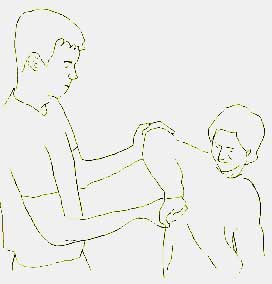Tendon Twisting
/ This is a continuation of the series on jin, that started below with a discussion of pulsing.
This is a continuation of the series on jin, that started below with a discussion of pulsing.Twisting integrates the body and is essential to make the mechanics of Taijiquan operative. Most sports, and even most martial arts, do not emphasis twisting enough. Twisting integrates the body because as you twist you take the slack out of tendons; if all the tendons throughout the body have an equal amount of twisting, the movement of the hand will be simultaneous with the movement of the foot.
This principle can be simply illustrated by stepping on one end of a towel and twisting the other end until it is like a thick rope. Movement at one end of the towel while it is slack at best sends a wave through the towel. After you have twisted it the whole thing moves as one flexible hunk.
 Twisting unevenly will cause lots of damage. That's how joint locks and breaks work. Practice on a chicken if you want. For instance, to bust the wrist, just twist it while immobilizing the elbow.
Twisting unevenly will cause lots of damage. That's how joint locks and breaks work. Practice on a chicken if you want. For instance, to bust the wrist, just twist it while immobilizing the elbow.This practice is the main reason that Chinese martial artists do not have or need big bulging arm or leg muscles.
Again, twisting is part of jin, it creates underlying dynamic structure. It is not itself a source of power, it does make the use of power more efficient.
Image: I got the image of the towel from this Heller Bodywork site, they are making a different but related point about the process of balancing.


 I have said before that most medicine comes from war.
I have said before that most medicine comes from war. nd too often was secret. There is also a long tradition of publishing best practices.
nd too often was secret. There is also a long tradition of publishing best practices. . For instance, a liver that doesn't move like a jellyfish when active, will slowly, over years, change the shape and alignment of the bones. An injury to the neck will effect the dexterity of the hand.
. For instance, a liver that doesn't move like a jellyfish when active, will slowly, over years, change the shape and alignment of the bones. An injury to the neck will effect the dexterity of the hand.
 One of the biggest challenges of being a teacher is that students are always trying to get me to equivocate. For instance, I say, "Practice standing completely still for one hour early in the morning, everyday, before you eat breakfast."
One of the biggest challenges of being a teacher is that students are always trying to get me to equivocate. For instance, I say, "Practice standing completely still for one hour early in the morning, everyday, before you eat breakfast." for purity and perfection. During the Sung and Ming dynasties the Chinese government gave out official titles to Orthodox Daoists. (Actually, even at times when the government had an anti-Daoist outlook, Daoshi, invested priests, had the status of "prince" if they were dragged into a magistrate's court. When the British won capitulation at the end of the Opium Wars, one of their demands was that Christian Missionaries be given the same status in court as Daoists. This was later one of the grievances of the Boxer rebellion.)
for purity and perfection. During the Sung and Ming dynasties the Chinese government gave out official titles to Orthodox Daoists. (Actually, even at times when the government had an anti-Daoist outlook, Daoshi, invested priests, had the status of "prince" if they were dragged into a magistrate's court. When the British won capitulation at the end of the Opium Wars, one of their demands was that Christian Missionaries be given the same status in court as Daoists. This was later one of the grievances of the Boxer rebellion.)
 subject,
subject,  toward them. I know of an old Gongfu master who worked bank security and kept a bit of metal-filings dust in his pocket to throw in peoples eyes if necessary. Better hope your blink reflex is operating if that happens. Taken to a possessed extreme, these are the bug eyes we sometimes see on crazy people.
toward them. I know of an old Gongfu master who worked bank security and kept a bit of metal-filings dust in his pocket to throw in peoples eyes if necessary. Better hope your blink reflex is operating if that happens. Taken to a possessed extreme, these are the bug eyes we sometimes see on crazy people. thought it was pretty funny and in good taste.
thought it was pretty funny and in good taste.